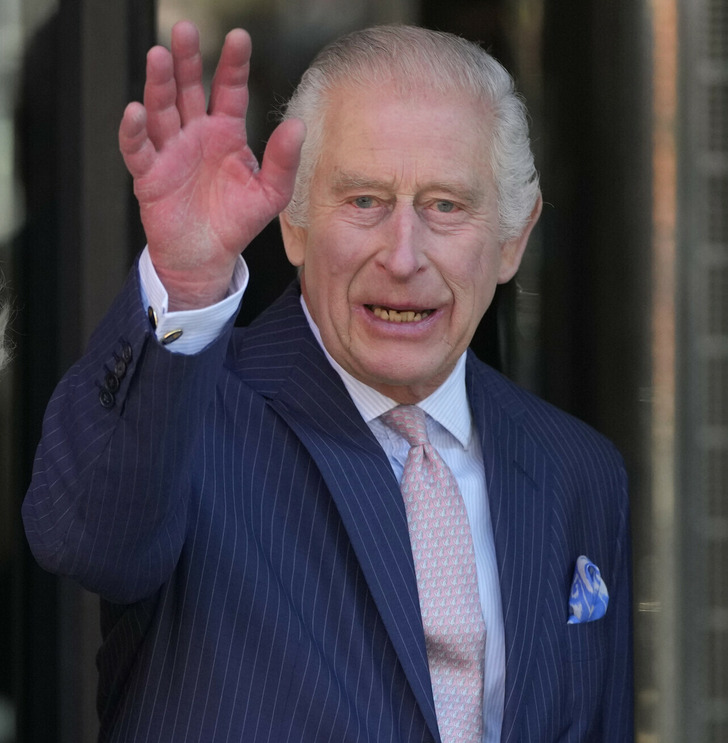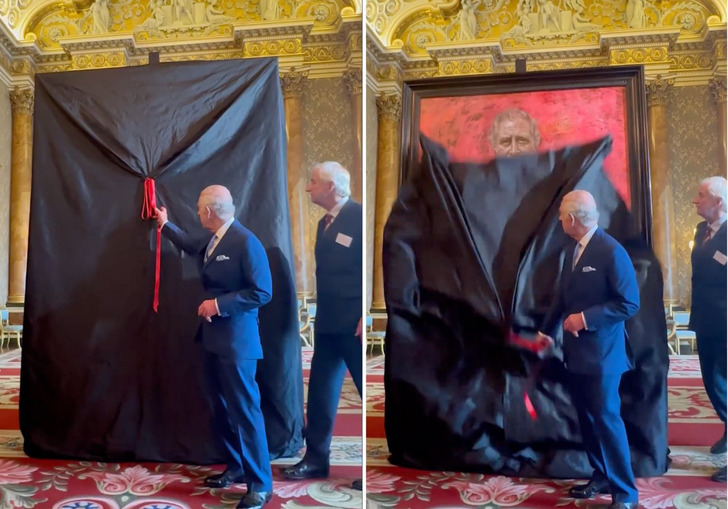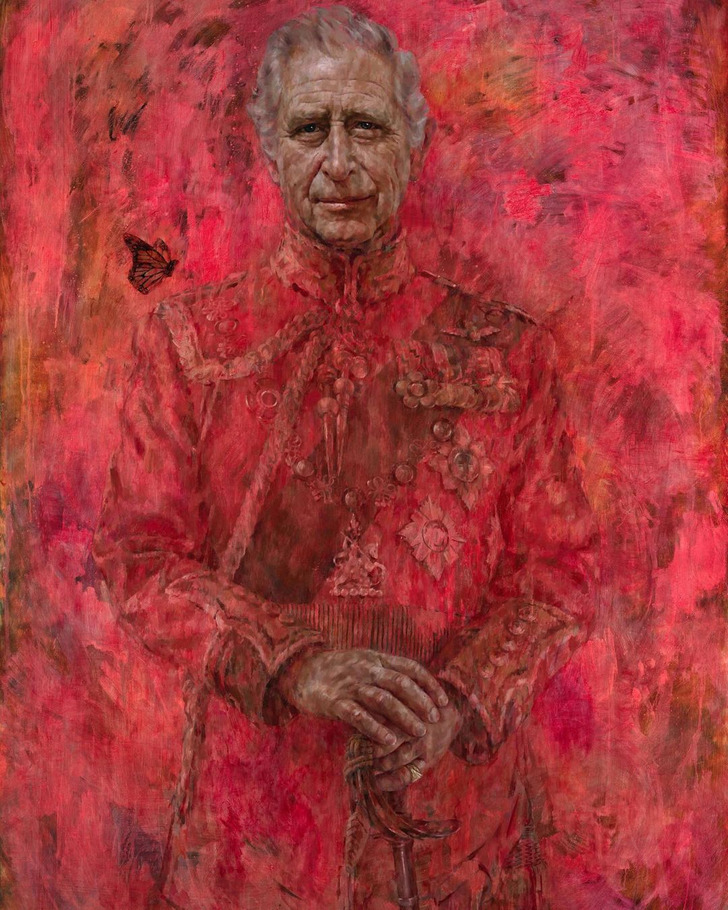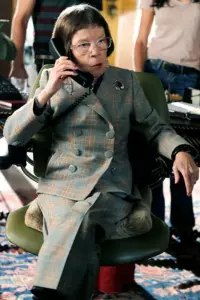In a dramatic unveiling that has left the public and critics buzzing, King Charles III revealed his first official portrait since ascending to the throne, and reactions have been anything but tepid. As debates rage on social media and in art circles, it is clear that King Charles’ portrait is destined to be one of the most talked-about royal artworks in recent history.
The unveiling

Recently, King Charles III personally unveiled a new portrait of himself at Buckingham Palace, the first such portrait since his coronation. The Royal Family’s Instagram account shared an exclusive video of the unveiling, featuring the king himself presenting the artwork.
This significant new work will ultimately be displayed in Drapers’ Hall in London, adding to its historical art collection and offering the public a glimpse of the monarch’s regal presence.
There was an ongoing debate in the comments.

The unveiling sparked a heated debate in the comments section on the Royal Family’s Instagram post and other social media sites. Opinions were sharply divided, with some users harshly criticizing the artwork. Comments ranged from “That is hideous” and “Without sounding rude, this is the worst royal portrait I’ve ever seen” to “100% thought this was satire.”
One critic remarked, “The face is good, the rest is appalling,” while another noted, “I would have loved this if it was any other color than red. He really captured the essence of him in the face, but the harshness of the red doesn’t match the softness of his expression.”
Despite the criticism, there were also voices of appreciation, such as “A lovely portrait of King Charles! I love the way the muted background draws attention to his face!” The mixed reactions highlight the polarizing nature of the portrait and the strong emotions it has evoked among the public.
The artist
Jonathan Yeo, a prominent figure in the world of figurative painting, has earned widespread acclaim for his unique blend of traditional and experimental portraiture. Yeo’s distinctive approach involves a deep engagement with his subjects, allowing him to capture their essence beyond mere physical appearance.
His recent portrait of King Charles III epitomizes this philosophy. Yeo explained, “As a portrait artist, you get this unique opportunity to spend time with and get to know a subject, so I wanted to minimize the visual distractions and allow people to connect with the human being underneath.”
The meaning of the portrait.
A particularly striking element of Yeo’s portrait is the inclusion of a butterfly. This detail serves multiple purposes, both symbolic and compositional. Yeo elaborated, “Primarily a symbol of the beauty and precariousness of nature, it highlights the environmental causes the King has championed most of his life and certainly long before they became a mainstream conversation.”
The butterfly also provides a visual contrast to the uniform, softening the portrayal and adding layers of meaning. “In the context of art history, a butterfly often symbolizes metamorphosis and rebirth, paralleling the King’s transition from Prince to monarch during the period the portrait was created,” Yeo noted, further emphasizing the transformative phase in King Charles’s life.

Yeo expressed his gratitude and honor for being commissioned to create such a significant portrait. “It was a privilege and pleasure to have been commissioned by The Drapers’ Company to paint this portrait of His Majesty The King, the first to be unveiled since his Coronation.”
Yeo’s approach to portraiture aims to encapsulate the life experiences and humanity etched into his subjects’ faces. “I do my best to capture the life experiences and humanity etched into any individual sitter’s face, and I hope that is what I have achieved in this portrait,” he explained.
The challenge of portraying a figure as complex and significant as King Charles III was substantial, but one that Yeo found immensely rewarding. “To try and capture that for His Majesty The King, who occupies such a unique role, was both a tremendous professional challenge, and one which I thoroughly enjoyed and am immensely grateful for,” he concluded. The portrait, destined for Drapers’ Hall in London, stands as a testament to both the artist’s skill and the monarch’s enduring legacy.
Discover the lesser-known facets of King Charles III’s life in our compelling article, “8 Things About King Charles III That Will Allow Us to Know Him More Closely.” Dive beyond the regal exterior to uncover intimate details about his passions, personal experiences, and unique quirks.
Preview photo credit Kin Cheung / Associated Press / East News, theroyalfamily / Instagram, jonathanyeo / Instagram
Linda Hunt Leaves Behind A Fortune That Makes Her Family Cry

The entertainment industry has long admired Linda Hunt, the well-known actress best recognized for portraying Hetty Lange in the hit television series “NCIS: Los Angeles.” As word of her leaving spreads, her family is said to have been moved to tears. Many have speculated about the enormous sum of money she leaves behind.
Due to her well-known roles in television and film, Hunt has accumulated wealth throughout the course of her multi-decade career. As the first actor to win an Oscar for playing a character of the opposite sex, Hunt is best remembered for her Academy Award–winning performance in “The Year of Living Dangerously.” This honor is not just for what she did on “NCIS: Los Angeles.” Her lengthy career and several accolades have significantly increased her net worth.

In addition to her acting pay, Hunt is well known for her wise financial decisions over the years. Her family has amassed a substantial wealth thanks to her real estate holdings and these investments. Hunt’s estate is said to include prestigious homes and other valuable items that have only increased in value over time.
Her accomplishments in Hollywood and her astute money management have contributed to her wealth. Her family has had to deal with their emotional reactions as they accept Hunt’s legacy since, although being described as quiet and humble, she made sure her loved ones would be well taken care of.
It’s clear that Linda Hunt’s financial influence has matched her contributions to the entertainment industry, even though her exact net worth is unclear. The emotional response from her family demonstrates her impact as an actress and as a loved one who carefully considered their future.

Please take note that the information provided is based on hearsay and general sources, and specifics of her estate and wealth distribution may vary.
Please share this article with your friends!



Leave a Reply